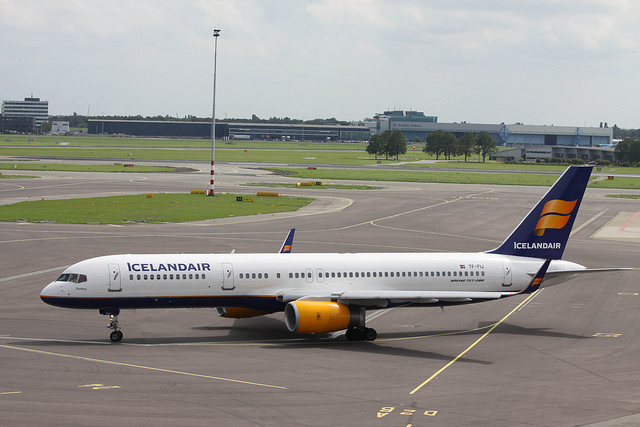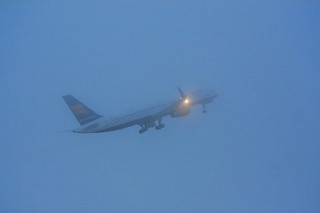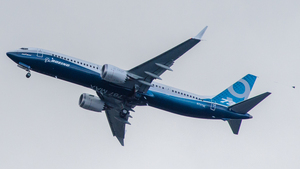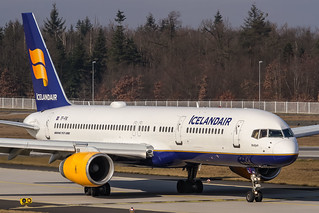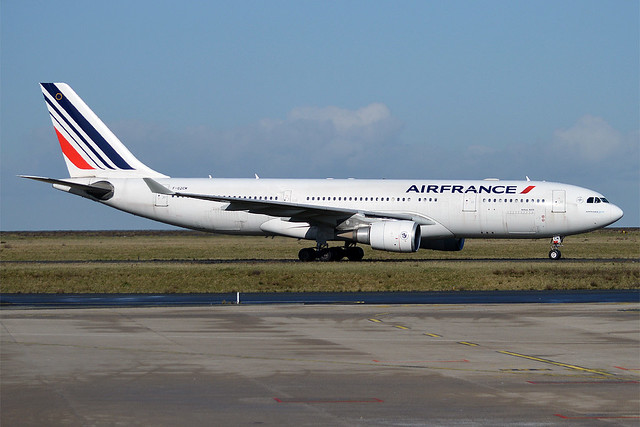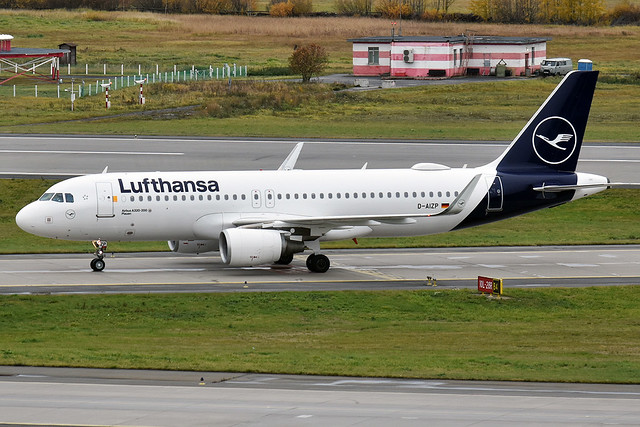Icelandair B752 at Keflavik on Feb 26th 2013, hydraulic failure, control difficulties
Last Update: August 21, 2015 / 15:13:07 GMT/Zulu time
Incident Facts
Date of incident
Feb 26, 2013
Classification
Incident
Cause
Hydraulic failure
Airline
Icelandair
Flight number
FI-213
Departure
Copenhagen, Denmark
Destination
Keflavik, Iceland
Aircraft Registration
TF-FIJ
Aircraft Type
Boeing 757-200
ICAO Type Designator
B752
The aircraft resumed service on Mar 10th 2013.
On Mar 30th 2013 the NTSB reported that the right hand hydraulic system failed when the aircraft was just at the top of descent. When the aircraft was on final approach about 4nm before touchdown on runway 20 with the autopilot engaged, the crew selected landing flaps, the aircraft however suddenly banked left and lost altitude, the crew had difficulty to regain control. After the crew regained control, the aircraft was climbed to safe altitude and entered a hold to troubleshoot the problem, then the crew managed a safe landing with flaps retracted. Iceland's RNF is investigating the occurrence, the NTSB is participating in the investigation with an accredited representative.
On Aug 21st 2015 Iceland's Air Accident Investigation Board RNSA released their final report concluding the causes of the serious incident were:
- Latent failure in the actuator of spoiler #6, due to a cracked Blocking and Thermal Relief Valve Housing
- Loss of right hydraulic system pressure due to cracked hydraulic tube
- Full deployment of the flaps, with the right hydraulic system unpressurized and the Blocking and Thermal Relief Valve Housing cracked, caused spoiler #6 to float
- Floating spoiler #6 separating the airflow over a section of the left wing, causing the airplane to roll to the left due to unbalance in lift between the left and the right wings
The RNSA reported that the aircraft was enroute at FL360 nearing to the top of descent into Keflavik when a flight attendant contacted the flight deck reporting he noticed a steady bass like sound had started in the center area of the aircraft about 5 minutes earlier, a sound like he had
never heard before on an aircraft. He was unable to locate the source of the sound. The flight crew checked their instruments, which showed no anomaly however. The lead flight attendant confirmed hearing that strange sound in the area of the wings and aft, too.
A short time later the flight crew initiated the descent towards Keflavik when during communication with Air Traffic Control an EICAS message came up indicating "R HYD QTY". While working the associated checklist another EICAS message came up "R HYD SYS PRESS". The crew was now fully aware of the failure of the right hand hydraulics system as well as associated system unavailabilities like right hand autopilot, a number of spoilers, right hand thrust reverser, right hand stabilizer and auto-brakes. Due to the length of the runway at Keflavik there was no problem with the increased landing distance demand.
During the descent the crew tested the spoilers and found them performing poorly, an EICAS message "SPOILERS" came up.
The aircraft was vectored for an ILS approach to Keflavik's runway 20 and was intercepting the localizer in instrument meteorologic conditions at 2600 feet MSL about 7.8nm before the runway threshold. The flaps were extended, the landing gear lowered and the glideslope intercepted, the flaps were selected to and reached 30 degrees. Descending through 2400 feet MSL the first officer (34, ATPL, 3,347 hours total, 2,770 hours on type), pilot flying, noticed vibrations and the aircraft began an uncommanded roll to the left. The first officer scanned instruments expecting an asymmetric indication, however there was none. The aircraft began to turn left. The first officer disconnected the autopilot and attempted to correct the problem by full right aileron, however, initially the aircraft did not respond. 5 seconds later the captain (49, ATPL, 12,660 hours total, 7,134 hours on type) instructed a go around and reduced the flaps to 20 degrees.
The aircraft had reached a maximum left bank angle of 34 degrees 8 seconds after the begin of the uncommanded left roll, despite full right aileron input by the first officer. The flaps now moved into the 20 degrees position and the aircraft began to respond again to the right aileron inputs, the bank angle reduced to 18 degrees left 20 seconds after the begin of the uncommanded left roll. The flaps were further retracted and when the flaps reached 5 degrees the crew assessed the aircraft was responding to aileron inputs again.
The aircraft climbed to 4000 feet and was wings level accelerating through 220 KIAS with flaps at 5 degrees resulting in flap overspeed, the aircraft pitched down, began to accelerate even further and increased to a rate of descent of 3500 fpm. The commander declared emergency reporting control difficulties, the flaps reached position 1 degrees and stopped leaving a flaps overspeed condition. The crew regained control and levelled the aircraft at 3000 feet, then climbed the aircraft upon ATC request, the flaps overspeed condition ceased. Two minutes 42 seconds after the uncommanded left roll the crew was in full control of the aircraft again.
The crew discussed the upset and concluded that it was flight controls related when the flaps were deployed to 30 degrees and decided to use flaps 15 for a second landing attempt requesting a long approach to runway 20. The crew requested, and the airline dispatched, a team of trauma experts to attend the passengers after landing.
The crew positioned the aircraft for a second approach to runway 20 and using flaps 15 managed a safe landing.
Following landing a crack in a hydraulic line in the right main gear was identified leaking hydraulic fluid. The hydraulic pressure was removed from the spoilers and the spoilers were attempted to be moved by hand, spoiler #2 did not move, spoiler #4 was stiff but did move, spoiler #6 moved easily. Spoilers #4 and #6 did not lock down as required in case of backpressure loss.
The RNSA wrote: "In the case of the actuator for spoiler #6, once the disassembly started it quickly became apparent that the Blocking and Thermal Relief Valve Housing was fractured. The component manufacturer (Moog) advised having seen this failure mode on several occasions, during overhauls, although never as a part of reported in-flight incident. These cases had not been reported to Boeing (the airplane manufacturer)."
The RNSA analysed that following the uncommanded left roll the crew was attempting to regain control while at the same time commencing a go around, the go-around altitude had not been set as result, the aircraft overshot the go-around altitude of 3000 feet. Being focussed on regaining control the crew forgot about the flaps being extended resulting in a flaps overspeed condition.
The RNSA analysed: "The flight crew stayed on tower frequency despite having received and acknowledged frequency change instructions. The investigations determined this to have occurred due to high workload of the flight crew during the incident."
The RNSA analysed: "The fractured Blocking and Thermal Relief Valve Housing, in spoiler #6 actuator, was a latent failure. It did not raise any flags with maintenance, because with the right hydraulic system working the hydraulic pressure in the actuator kept the spoilers from floating. Once the right hydraulic system became non-functioning, due to the cracked hydraulic tube, the hydraulic back pressure in the actuator was no longer present. This, combined with the fractured Blocking and Thermal Relief Valve Housing, allowed spoiler #6 to float when the flaps were fully extended."
Incident Facts
Date of incident
Feb 26, 2013
Classification
Incident
Cause
Hydraulic failure
Airline
Icelandair
Flight number
FI-213
Departure
Copenhagen, Denmark
Destination
Keflavik, Iceland
Aircraft Registration
TF-FIJ
Aircraft Type
Boeing 757-200
ICAO Type Designator
B752
This article is published under license from Avherald.com. © of text by Avherald.com.
Article source
You can read 2 more free articles without a subscription.
Subscribe now and continue reading without any limits!
Read unlimited articles and receive our daily update briefing. Gain better insights into what is happening in commercial aviation safety.
Send tip
Support AeroInside by sending a small tip amount.
Related articles
Icelandair B752 at Keflavik on May 18th 2012, dropped wheel on departure
An Icelandair Boeing 757-200, registration TF-FIJ performing flight FI-689 from Keflavik (Iceland) to Orlando,FL (USA) with 191 passengers, was…
Iceland B752 at Keflavik on Oct 28th 2019, landed on closed and occupied runway in fuel emergency
An Icelandair Boeing 757-200, registration TF-ISF performing flight FI-680 (dep Oct 27th) from Seattle,WA (USA) to Keflavik (Iceland) with 178…
Iceland B752 at Varanasi on Nov 10th 2023, tail strike on landing
An Icelandair Boeing 757-200, registration TF-LLL performing charter flight FI-1253 from Kathmandu (Nepal) to Varanasi (India), landed on Varanasi's…
Iceland B752 near Minneapolis on Jun 7th 2023, cabin pressure problems
An Iceland Air Boeing 757-200, registration TF-ISR performing flight FI-670 from Denver,CO (USA) to Keflavik (Iceland), was enroute at FL350 about…
Iceland B39M at Toronto on Mar 4th 2023, tail strike on balked landing
An Icelandair Boeing 737-9 MAX, registration TF-ICA performing flight FI-603 from Keflavik (Iceland) to Toronto,ON (Canada) with 177 passengers and 6…
ICE B752 enroute on Feb 27th 2023, engine issue
An Icelandair Boeing 757-200, registration TF-FIK performing flight FI-454 from Keflavik (Iceland) to London Heathrow,EN (UK), was enroute at FL370…
Newest articles
France A332 near Munich on Jan 4th 2026, toxic fumes on board
An Air France Airbus A330-200, registration F-GZCM performing flight AF-565 from Beirut (Lebanon) to Paris Charles de Gaulle (France), was enroute at…
Lufthansa A320 at Cluj on Jan 4th 2026, bird strike
A Lufthansa Airbus A320-200, registration D-AIZP performing flight LH-1668 from Munich (Germany) to Cluj (Romania), was on final approach to Cluj's…
Subscribe today
Are you researching aviation incidents? Get access to AeroInside Insights, unlimited read access and receive the daily newsletter.
Pick your plan and subscribePartner

ELITE Simulation Solutions is a leading global provider of Flight Simulation Training Devices, IFR training software as well as flight controls and related services. Find out more.
SafetyScan Pro provides streamlined access to thousands of aviation accident reports. Tailored for your safety management efforts. Book your demo today
AeroInside Blog
Popular aircraft
Airbus A320Boeing 737-800
Boeing 737-800 MAX
Popular airlines
American AirlinesUnited
Delta
Air Canada
Lufthansa
British Airways

